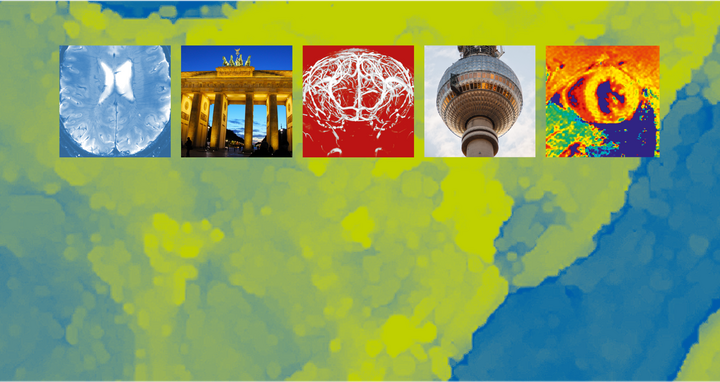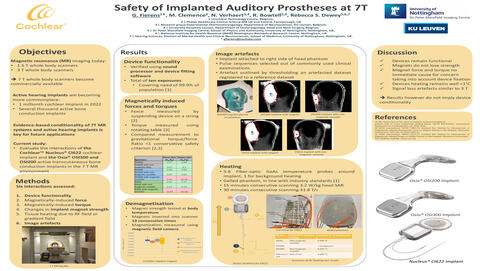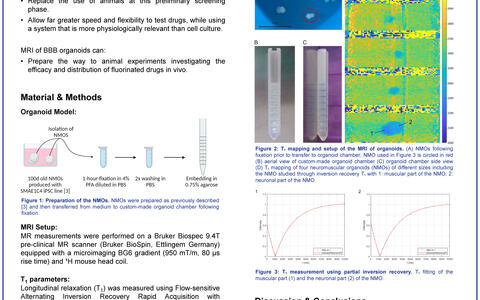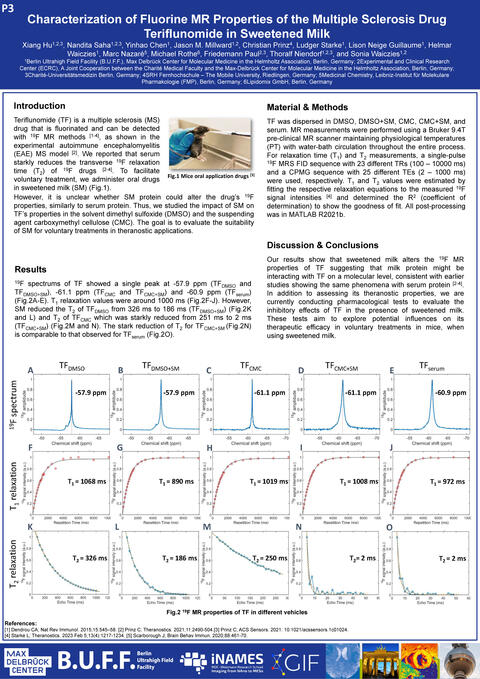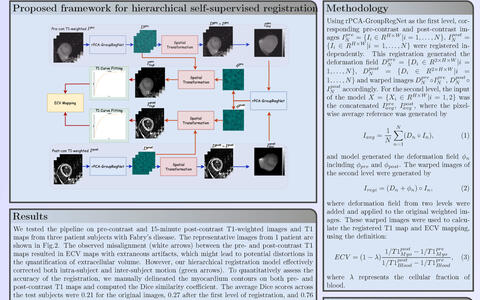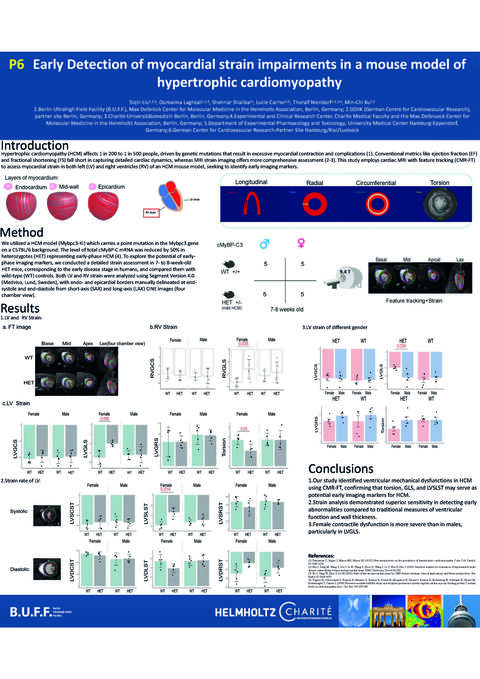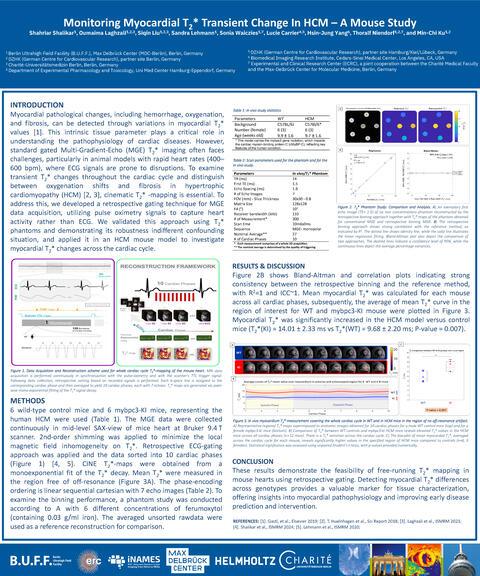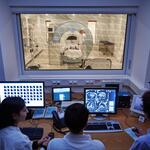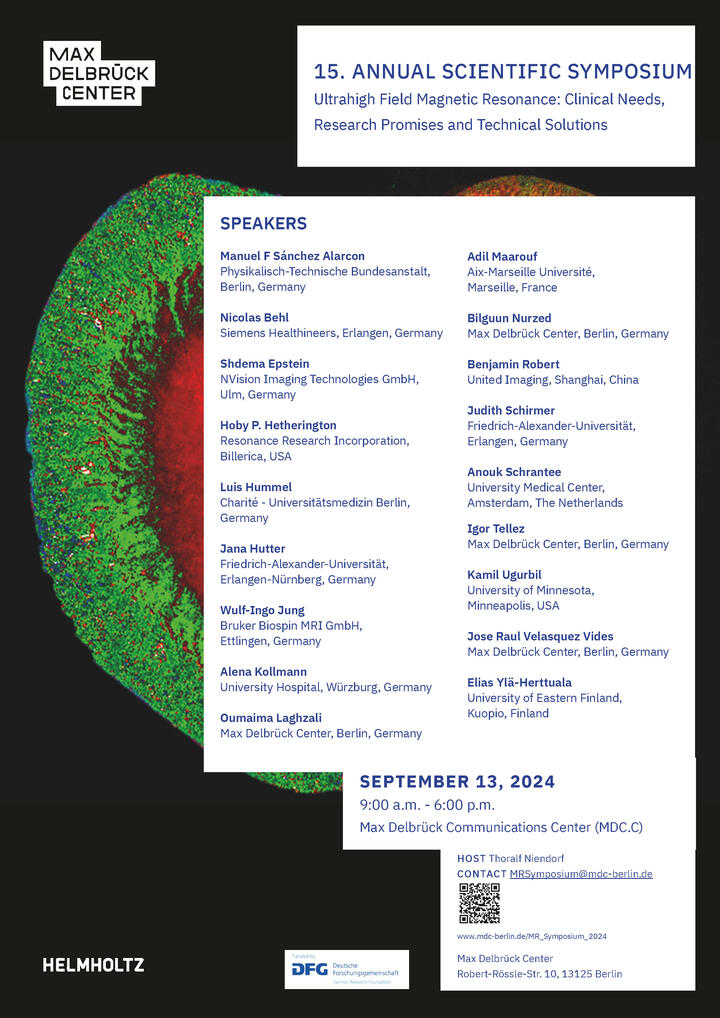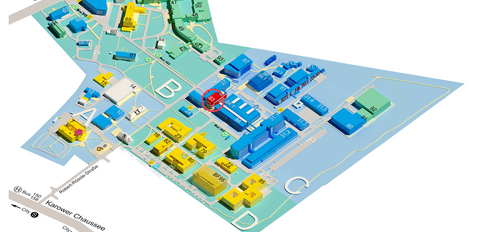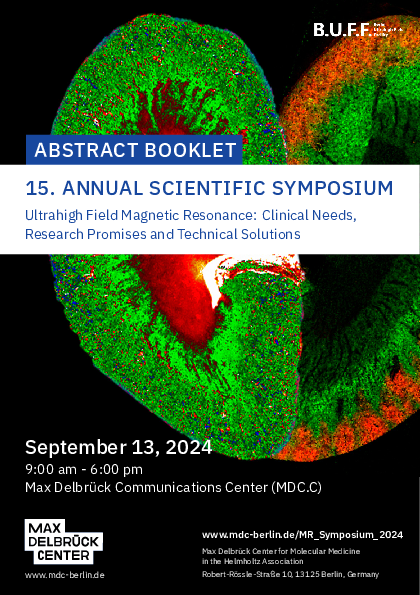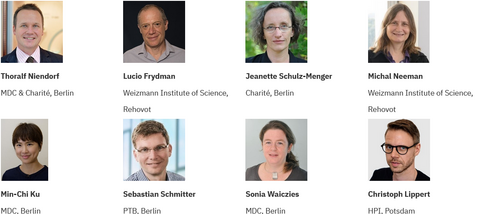15. Annual Scientific Symposium Ultrahigh Field Magnetic Resonance: Clinical Needs, Research Promises and Technical Solutions
Follow us on X (formerly known as Twitter)
@BUFF_MRI #UHFsymposium
Dear colleagues and friends,
Great thanks for your interest in the 15th Scientific Symposium on Clinical Needs, Research Promises and Technical Solutions in Ultrahigh Field Magnetic Resonance, which is being held on September 13th 2024. It is a hybrid experience that combines our established in-person meeting and setup with a virtual meeting in favour of changing scientific communication and exchange for the better.
Imaging bridges a crucial gap in space and time in life science and medicine: from atomic to anatomic objects to whole body imaging, from picoseconds to years in population studies. New molecular and cellular insights are obtained from imaging. These findings should be integrated with data science into a coherent picture of tissues, organs and organisms for early interception of disease. These fundamental developments call for hitherto unavailable research frameworks, international partnership and collaborative culture to promote strong ties across multiple research domains and imaging modalities; connecting nanoscopic views, length scales, time scales and mesoscopic pictures with mechanistic insights and macroscopic function of biological and clinical importance.
The field of Magnetic Resonance (MR) has evolved rapidly over the past quarter of a century, allowing for an ever growing number of applications across a broad spectrum of basic, translational and clinical research. One important development which is in the spotlight of MR research is Ultrahigh Field Magnetic Resonance (UHF-MR). The pace of discovery is heartening and a powerful motivator to transfer the lessons learned at ultrahigh fields from basic research into the clinical scenario. These efforts are fueled by the unmet clinical needs and the quest for advancing the capabilities of diagnostic MR imaging – today.
The development of UHF-MR is moving forward at an amazing speed that is breaking through technical barriers almost as fast as they appear. UHF-MR has become an engine for innovation in experimental and clinical research. The reasons for moving UHF-MR into clinical applications are more compelling than ever. Images from these instruments have revealed new aspects of the anatomy, functions and physio-metabolic characteristics of the brain, heart, joints, kidneys, liver, eye, and other organs/tissues, at an unparalleled quality. UHF-MR has a staggering number of potential uses in neuroscience, neurology, radiology, neuroradiology, cardiology, internal medicine, oncology, nephrology, ophthalmology and other related clinical fields. As they are developed, we will push the boundaries of MR physics, biomedical engineering and biomedical sciences in many other ways.
With 7.0 T human MRI now widely used in clinical research, there is increasing interest in exploring even higher magnetic field strengths. This includes pioneering reports on MRI technology at 9.4 T, 10.5 T and 11.7 T and corresponding in vivo applications. The MR research and superconductor science community have already taken even more ambitious steps towards future, envisioning human MR at 14.0 T. Recently, the Dutch National 14 Tesla Initiative in Medical Science received funding for the implementation of the first 14.0 T class human MR instrument. Joint efforts of the nuclear magnetic resonance (NMR) and MRI communities identified the scientific question that drives these ambitions, together with the technological challenges and prospects for achieving human MRI at 20.0 T. These bold steps will require rigorous technical developments, assessment of physiological constraints and in vivo evaluation studies, that have to be tested and validated by those who adopt the technology. The symposium offers ample opportunity for discussion and exchange on how such efforts can lead to valuable results.
Realizing these opportunities, we are very much delighted to announce the 15th Annual Scientific Symposium on Clinical Needs, Research Promises and Technical Solutions in Ultrahigh Field MR, which will be held from September 13th, 2024 in Berlin, Germany. Please save the date. The symposium is designed to provide an overview of state-of-the-art (pre)clinical UHF-MR and its connection with data science, to discuss the clinical relevance of UHF-MR, to explore future directions of UHF-MR, to foster explorations into ultrahigh field-MR and to initiate local, regional, national and international collaboration and last but not least to provide plenty of time to engage into fruitful exchange with peers and colleagues. The symposium is tailored to attract basic scientists, engineers, hardware professionals, translational researchers, applied scientists and clinicians with all levels of experience and expertise ranging from undergraduate and graduate students interested in imaging to trainees, advanced users and applications experts
- Scientific Program
- The scientific program comprises 4 sessions, all balancing technical developments, clinical applications and hot topics related to the synergies between imaging and data science. The scientific program is designed to lay extensive bridges between disciplines to enable the translation of multimodal AI technology into clinically-relevant imaging guided diagnostics, therapy monitoring and digital health applications. We are very much honored to present extraordinary speakers including MR technology leaders, data science specialists and distinguished clinical experts - all bridging disciplinary boundaries and stimulating the imaging and data science communities to throw further weight behind the solution of unsolved problems and unmet clinical needs.
- Scientific Session I
- GETTING TO THE MATTER OF THE HEART: CLINICAL NEEDS AND RESEARCH PROMISES OF CARDIOVASCULAR AND BODY UHF-MR
09:00 WELCOME
chair: Thoralf Niendorf, Berlin, Germany
Sonia Waiczies, Berlin, Germany
Chair:
Jutta Ellermann, Minneapolis, USA
Thoralf Niendorf, Berlin, Germany09:10 Accelerated B1+ Mapping and Interleaved 23Na/1H (pTx) MRI for Abdominal Imaging at 7T
Judith Schirmer, Friedrich-Alexander-Universität, Erlangen, Germany
09:30 It is all About Reproducibility: A 3-Year and an Inter-Day Study on the Robustness of Universal Excitation Pulses for Cardiac MRI at 7.0 T
Manuel F. Sánchez Alarcon, Physikalisch-Technische Bundesanstalt, Berlin, Germany
09:50 Translational cardiovascular research: Cardiac MRI in Large Animal Models at 7.0 T
Alena Kollmann, University Hospital, Würzburg, Germany
10:10 From Macrostructure to Microarchitecture: Comprehensive Cardiac MRI of Myocardial Reorganization in Hypertrophic Cardiomyopathy
Oumaima Laghzali, Max Delbrück Center, Berlin, Germany
10:30 Hierarchical Self-Supervised Registration Pipeline for Enhancing Quantitative Cardiac MRI
Xinqi Li, Biomedical Imaging Research Institute, Cedars-Sinai Medical Center, Los Angeles, USA
Early Detection of Myocardial Strain Impairments in a Mouse Model of Hypertrophic Cardiomyopathy
Siqin Liu, Max Delbrück Center, Berlin, Germany
Monitoring Myocardial T2* Transient Change in HCM: A Mouse Study
Shahriar Shalikar, Max Delbrück Center, Berlin, Germany
10:40 PANEL DISCUSSION: CARDIAC AND BODY MRI at UHF
chair: Jutta Ellermann, Minneapolis, USA
Christoph Aigner, Berlin, Germany
10:55 COFFEE BREAK / RELAXATION WITH LIVE MUSIC - Scientific Session II
- GETTING TO THE MATTER OF THE BRAIN: CLINCIAL NEEDS AND RESEARCH PROMISES FOR NEUROVASCULAR UHF-MR AND RELATED FIELDS
Chairs:
Kamil Ugurbil, Minneapolis, USA
Min-Chi Ku, Berlin, Germany11:15 Functional 1H MRS and fMRI of the Brain to Decipher the Neurometabolite Response at 7.0 T
Anouk Schrantee, University Medical Center, Amsterdam, The Netherlands
11:35 Are Cortical Lesions an Early Hallmark of Multiple Sclerosis? The Answer is Provided by 7.0 T MRI
Adil Maarouf, Aix-Marseille Université, Marseille, France
11:55 Precision fMRI at 7.0 T: How to Fix Cluster-Failure in the Individual Brain
Igor F. Tellez Ceja, Max Delbrück Center, Berlin, Germany
12:15 High Accuracy Magnetic Field Shimming for Workflow Optimization: Methodology and Applications
Hoby P. Hetherington, Resonance Research Incorporation, Billerica, USA
12:35 Poster Power Session (3 x 3 min)
Exploring the Topography of Metabolic Alterations in Multiple Sclerosis Using Fast High-Resolution 3D-MR Spectroscopic Imaging at 7.0 T
Eva Niess, Medical University of Vienna, Vienna, Austria
Safety of Implanted Auditory Prostheses at 7.0 T
Guy Fierens, Cochlear Technology Centre, Mechelen, Belgium
High Permittivity Dielectric Metasurfe Enhances Transmission Efficiency of a Surface Loop at 7.0 T
Nandita Saha, Max Delbrück Center, Berlin, Germany12:45 PANEL DISCUSSION: BRAIN MRI at UHF
chair: Sonia Waiczies, Berlin, Germany
Assaf Tal, Rehovot, Israel
13:00 LUNCH BREAK / BREAKFAST BREAK - Scientific Session III
- TRANSLATIONAL RESEARCH: FROM BLUE SKY EXPLORATIONS EN ROUTE TO CLINICAL APPLICATIONS
Chairs:
Kamil Ugurbil, Minneapolis, USA
Nandita Saha, Berlin, Germany13:45 Sea to Summit: Progress in Preclinical MR at Ultrahigh and Extreme Magnetic Fields
Wulf-Ingo Jung, Bruker Biospin MRI GmbH, Ettlingen, Germany14:05 Of Possibilities and Pitfalls: Exploring Traces of Gadolinium Based Contrast Agents in the Kidney Using Mass Spectrometry and MRI
Luis Hummel, Charité, Berlin, Germany
14:25 Probing Myocardial Fibrosis and Scar Tissue with Quantitative MRI
Elias Ylä-Herttuala, University of Eastern Finland, Kuopio, Finland
14:45 Accelerated Simultaneous T2 and T2* Mapping of the Brain and Beyond
Jose Raul Velasquez Vides, Max Delbrück Center, Berlin, Germany
15:05 Can Hyperpolarization Add Value to Ultrahigh Field MRI?
Shdema Epstein, NVision Imaging Technologies GmbH, Ulm, Germany
15:25 Poster Power Session (4 x 3 min)
Separation of Cellular (R2t*), Vascular (R2') and Macroscopic B0 Field Inhomogeneity (Background Gradients) Contributions to the R2* Signal Relaxation at UHF-MR
Joanna Im, Mallinckrodt Institute of Radiology, Washington University, St. Louis, USA
Characterization of Neuromuscular Organoids for Future Organoid MRI
Lison Guillaume, Max Delbrück Center, Berlin, Germany
Characterization of Fluorine MR Properties of the Multiple Sclerosis Drug Teriflunomide in Sweetened Milk
Xiang Hu, Max Delbrück Center, Berlin, Germany
In Vivo Monitoring of Renal Tubule Volume Fraction During Acute Tubular Pressure Increase Using Dynamic T2 Mapping
Ehsan Tasbihi, Max Delbrück Center, Berlin, Germany15:35 PANEL DISCUSSION: TRANSLATIONAL MRI at UHF
chair: Jason Millward, Berlin, Germany
Sonia Waiczies, Berlin, Germany
15:50 LUNCH BREAK / BREAKFAST BREAK - Scientific Session IV
- LOOKING AT THE HORIZON
Chairs:
Thoralf Niendorf, Berlin Germany
Bernd Ittermann, Berlin, Germany16:15 Why all the Fuss About 7.0 T MRI? Smart Imaging of the Fetal Brain and Placenta at 0.55 T
Jana Hutter, Friedrich-Alexander-Universität, Erlangen-Nürnberg, Germany
16:35 MRI at 10.5 T Matters
Kamil Ugurbil, University of Minnesota, Minneapolis, USA16:55 Beyond: 3D Metamaterial Facilitates Human Cardiac MRI at 21.0 T
Bilguun Nurzed, Max Delbrück Center, Berlin, Germany17:15 MRI at 5.0 T: Technology, Progress and Clinical Applications
Benjamin Robert, United Imaging, Shanghai, PRC
17:35 Nova Terra: Progress in Clinical Ultrahigh Field MRI at 7.0 T
Nicolas Behl, Siemens Healthineers, Erlangen, Germany17:55 PANEL DISCUSSION: FUTURE of UHF MRI
chair: Kamil Ugurbil, Minneapolis, USA
Bernd Ittermann, Berlin, Germany
18:10 Get Together - (Virtual) Poster sessions
- We are looking forward to your scientific contributions in form of posters. Please note that the symposium’s poster price competition will consider all submitted posters hence, encouraging you to walk the extra mileage. The scientific program includes a number of 3-minute slots for speedy poster power presentations. This will give many of you the opportunity to be in the spotlight of the audience.
Virtual Poster Session
P1
Safety of Implanted Auditory Prostheses at 7TFor Question please contact the Author
P2
Characterization of Neuromuscular organoids for future Organoid Magnetic Resonance ImagingFor Question please contact the Author
P3
Characterization of Fluorine MR Properties of the Multiple Sclerosis Drug Teriflunomide in
Sweetened MilkFor Question please contact the Author
P4
Separation of Cellular (R2t*), Vascular (R2'), and Macroscopic B0 Field Inhomogeneity (Background Gradients) Contributions to the R2* Signal Relaxation at Ultra-High Fields with quantitative Gradient Recalled Echo (qGRE) MRIFor Question please contact the Author
P5
Hierarchical Self-Supervised Registration Pipeline for Enhancing Quantitative Cardiac MRIFor Question please contact the Author
P6
Hierarchical Self-Supervised Registration Pipeline for Enhancing Quantitative Cardiac MRIFor Question please contact the Author
P8
High Permittivity Dielectric Metasurface Enhances Transmission Efficiency of a Surface Loop at 7T
For Question please contact the Author
P9
Monitoring myocardial T2* transient change in HCM – a mouse studyFor Question please contact the Author
P10
In Vivo Monitoring of Renal Tubule Volume Fraction During Acute Tubular Pressure Increase Using Dynamic T2 MappingFor Question please contact the Author
- Information
CONFERENCE OFFICE:
Dr. Timkehet Teffera
Congress Manager
Max Delbrück Center for Molecular Medicine in the Helmholtz Association (MDC)
Robert-Rössle-Str. 10
13125 Berlin
Phone: +49 30 94064255
Lien-Georgina Dettmann
Congress Manager
Max Delbrück Center for Molecular Medicine in the Helmholtz Association (MDC)
Robert-Rössle-Str. 10
13125 Berlin
Phone: +49 30 94062719
Matthias Runow
Congress Manager
Max Delbrück Center for Molecular Medicine in the Helmholtz Association (MDC)
Robert-Rössle-Str. 10
13125 Berlin
Phone: +49 30 94063720
E-Mail: MRsymposium@mdc-berlin.deOFFICE PROF. NIENDORF
Carolin Bechtloff
Max Delbrück Center for Molecular Medicine in the Helmholtz Association (MDC)
Robert-Rössle-Straße 10
13125 Berlin
Phone: +49 30 94063978E-Mail: Carolin.Bechtloff@mdc-berlin.de
Professional Child care
Many of us are aware of the fact how balancing work and family poses challenges for parents. The Max Delbrück Center is devoted to offset this challenge and contribute its level best towards harmonizing the competing needs of families with the mission to advance science. It is the relentless effort that made it to a proud "Work and Family" awardee. To this end we are very pleased to offer professional child care for the course of this annual scientific symposium. Please get in touch with us if you need information and support in this regard.
Online Access
You can access the virtual part of the symposium via the following link
Poster sessions
The scientific program will be paralleled by a poster session where all posters are made available electronically. We are looking forward to your poster contributions which will be all considered for the symposium’s poster price contest. We wish to encourage those of you who are courageous to walk the extra mileage. We have included numerous slots of 3 min speedy poster power presentations into the program. This will give a large number of poster presenters the opportunity to be in the spotlight of the audience.
Venue
Max Delbrück Center
Robert-Rössle-Straße 10
Axon 1
13125 Berlin
Germany

